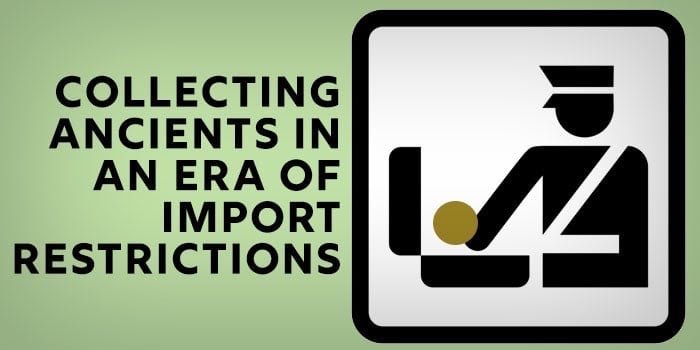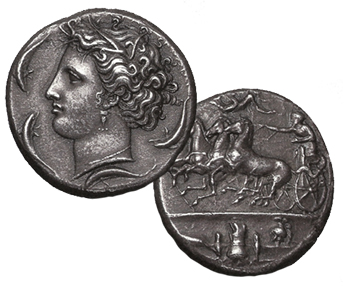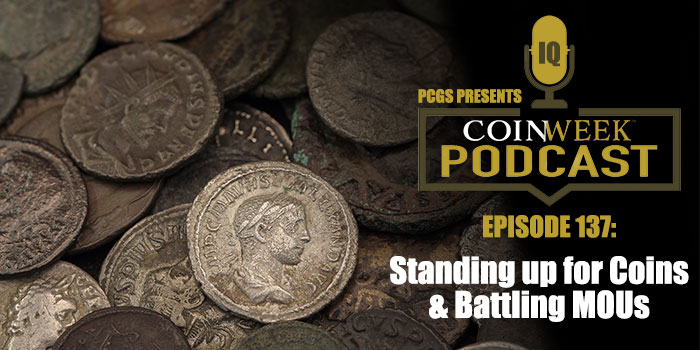
By Tyler Rossi for CoinWeek …..
Ask a collector of ancient coins if they have ever bought a coin from an overseas vendor, and you will more likely than not receive a positive response.
And while many collectors will have never experienced a problem with Customs, everyone will have heard at least a few horror stories of coins being delayed or even seized. While these collectors are not smugglers–and the vendors have almost definitely filled out the paperwork as accurately as possible–they have still fallen victim to an overly complex and ill-defined system of enforcement that represents what has been called by my CoinWeek colleague Mike Markowitz a “global war against collectors” of ancient coins.
It would be futile to argue that ancient coins are never subject to archaeological looting. In fact, a grouping of 91 gold Roman Imperial coins and 3,000 other coins, valued at over half a million dollars US, were recently seized in a massive operation called Pandora VI. Initiated by the Spanish Guardia Civil and organized by Europol, INTERPOL, and the World Customs Organization, it engaged 28 different countries. This operation made national news in March of this year. But while definitely a major case, Pandora VI is actually rather unusual, since most items of cultural importance seized by Customs are in fact smuggled coins. Usually, coins make up only a fraction of looted and smuggled goods.
Despite this, many Western countries have begun to ban the importation of ancient coins.
In the United States, this drive began back in 1983 when the national government first passed the Convention on Cultural Property Implementation Act (CPIA). This law was created as a vehicle to implement the 1970 UNESCO Convention on the Means of Prohibiting and Preventing the Illicit Import, Export and Transfer of Ownership of Cultural Property. By creating this framework, UNESCO was hoping to enable cooperation between governments in the fight to protect cultural heritage and limit the looting or smuggling of archaeological items.

Shortly thereafter, the CPIA was used to establish the Cultural Property Advisory Committee (CPAC). This panel of presidential appointees has 11 members sorted into several categories: two represent museums; three represent the fields of archaeology, anthropology, and ethnology; three are experts in the international sale of cultural property; and the last three represent the general public. Unfortunately, this panel is not finely attuned to the details surrounding ancient numismatics. They are, however, responsible for advising the government (both the president and the State Department) regarding which restrictions are necessary and which ones will be most effective. The US Customs Bureau claims to have repatriated over 12,000 objects since they began policing for cultural heritage.
Initially, the CPIA was used to narrowly enforce the import restriction on items that truly hold cultural and historic importance. But, by the early 1990s, the situation had begun to change, and Italy, Cyprus, and China placed restrictions on ancient coins. In the present day, we see restrictions on coins from 16 countries: Afghanistan, Albania, Algeria, Bulgaria, China, Egypt, Greece, Iraq, Italy, Jordan, Libya, Morocco, Syria, Turkey, and Yemen. Most of these restrictions come in the form of bilateral Memoranda of Understanding (MoU) between each respective country and the USA that bind each party to prevent the importation of proscribed items.
It has been argued repeatedly that coins should not be included at all. Firstly, they are generally not fragile, and under normal circumstances are not likely to suffer damage while in private hands. Secondly, there are literally millions of ancient coins that have been excavated to date. Additionally, coins are made for circulation, and ancient silver and gold coins in particular were intended for international trade. These arguments only highlight the fallacy of labeling ancient coins as the vital cultural heritage of modern states, the majority of which do not represent the current iteration of those ancient states.
Ancient coins can be imported into the US under the CPIA regime if one of several conditions are met. I sat down with Peter Tompa, a well-known legal expert on the subject, to discuss the present state of these regulations and what he sees as the greatest threats facing the hobby.
First, the coins must pass what Mr. Tompa called a “cultural significance test”. There must be physical and scholarly evidence that the coins were not only found in but also not made in that country. This is an important point, because the lists of coins are written to reflect general knowledge of where the coin type was struck and usually excavated. For example, a Roman coin struck in Tangier would be covered under the Morocco – US MoU. But if the type did not exclusively circulate in Morocco, and was instead found in Spain, it would still fall under Moroccan MoU.

Second, the country of origin may issue an export certificate, yet, according to Mr. Tompa, this almost never happens.
And lastly, ancient coins can be imported to the US if the importer can provide a significant provenance that proves that the item had left the country of origin (i.e., the country of manufacture) before the MoU was signed or at least 10 years prior to its importation into the US. When asked about this topic, Mr. Tompa stated that the “trigger” for these countdowns should be when the coin left the country of origin, but he believes that Customs “enforce[s] based [on] when it is imported into the US” – which significantly shortens the timeline.
Additionally, as many collectors know, for coins worth less than a few hundred dollars, it is usually impossible to trace the provenance back more than 10 or 15 years. Not only this, but the Customs agent is the one to determine if the evidence provided is sufficient, and so the level of rigor varies greatly from case to case.
Mr. Tompa also stated that Customs enforcement is quite “spotty”. He also stated that since they view their mandate, granted by the CPIA, as far broader than it actually is, it is not unusual for Customs agents to be much stricter with packages containing coins from countries of origin in the Middle East or North Africa. This causes some confusion with collectors, since, on the Customs form, they are looking for where the coin was produced and not where it is being imported from.
And since Customs can impound coins for five years, it is not unusual for a package simply to go missing for quite some time with little to no communication, and then be delivered years later.
These regulations, and all the paperwork needed to legally import ancient coins to the US, have had a severe chilling effect on the hobby. While many collectors know that there are some restrictions, they either do not know the true width and breadth or are unaware of some specific clause. Regardless, there is a general lack of knowledge in the numismatic community surrounding this issue. It is so pervasive that Mr. Tompa reports he is contacted multiple times a month by collectors who are only just learning about the import restrictions and searching for additional information.
Many existing MoUs have been renewed and expanded in recent years. Cyprus and Greece, for example, moved their cutoff date forward into the Middle Ages, effectively placing an “embargo on all Byzantine and Medieval coins that circulated in Greece, despite the statutory language” in the current MoU (Stark, 2021). The CPAC is now debating on what their recommendation should be to the State Department, regarding the extension of Belize and Libya’s MoUs.
When asked about the future of the hobby in relation to these regulations, Mr. Tompa stated that while there is no one regulation that bans the importation of ancient coins to the US, the hobby is facing a “death by [a] 1,000 cuts”, especially if the State Department continues to “actively solicit countries.” In fact, we discussed how a series of significant private donations have been made directly to the US Government in order to enable the State Department to distribute monetary grants aimed at assisting people in foreign countries to write additional MoUs. Mr. Tompa continued, stating that he believes despite all public assurances to the contrary, that “they [the State Department] want to restrict everything.”.
When asked what can be done, Mr. Tompa stated that we can still influence the CPAC and the State Department through continued lobbying in an attempt to educate them on the differences between mass-produced coins intended for international circulation and culturally significant historical artifacts. Mr. Tompa believes that this can be achieved – especially if the CPAC has a numismatist permanently on staff “who isn’t American, doesn’t have any interest, and is an expert.” For example, as Mr. Tompa suggested, this could be a British Museum employee.
While the State Department and CPAC work with various experts in the US to draw up lists of restricted coins, it is important to note that the American Numismatic Society (ANS), which has members that may have contributed independently to this work, reports no formal relationship with either group.
Overall, it is vital for collectors to be aware of the existing regulations in order to both protect themselves specifically and the hobby more generally. To that end, this webpage maintained by the Ancient Coin Collectors Guild (ACCG) is a highly valuable source of up to date information.
Happy (and safe) collecting!
* * *
Sources
Interview with Peter K. Tompa, 2022
ANA, 2022 – https://www.money.org/consumer-awareness/ancient-coin-import-restrictions
Stark, 2021 – https://www.coinworld.com/news/world-coins/extension-expands-import-restrictions-on-coins-that-circulated-in-greece
https://accguild.org/Ancient-Coin-Import-Restrictions
https://coinweek.com/ancient-coins/global-war-collectors-ancient-coins/
https://eca.state.gov/cultural-heritage-center/cultural-property/committee-members
* * *
About the Author
Tyler Rossi is currently a graduate student at Brandeis University’s Heller School of Social Policy and Management and studies Sustainable International Development and Conflict Resolution. Before graduating from American University in Washington D.C., he worked for Save the Children creating and running international development projects. Recently, Tyler returned to the US from living abroad in the Republic of North Macedonia, where he served as a Peace Corps volunteer for three years. Tyler is an avid numismatist and for over a decade has cultivated a deep interest in pre-modern and ancient coinage from around the world. He is a member of the American Numismatic Association (ANA).
* * *
CoinWeek editor Charles Morgan also spoke with Tompa a few years ago for the CoinWeek Podcast about the Italian MoU and cultural property issues that impact ancient coin collecting–listen below:
CoinWeek Podcast #137: Standing Up for Coins and Battling MoUs (with Peter Tompa)
Mobile phone users. Stream this podcast for free by downloading the podomatic app or subscribe to the CoinWeek Podcast on iTunes.






How ridiculous. Coins should not be part of these restrictions. More useless bureaucracy to hurt little people.